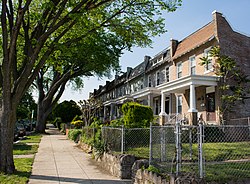Barney Circle, Washington, D.C.
| Barney Circle | |
|---|---|
| Neighborhood | |

800 block of Kentucky Avenue SE in the
Barney Circle neighborhood |
|
 Map of Washington, D.C., with the Barney Circle neighborhood highlighted in red |
|
| Coordinates: 38°52′42.6″N 076°58′50.5194″W / 38.878500°N 76.980699833°W | |
| Country | United States |
| Territory | Washington, D.C. |
| Constructed | c. 1917 |
| Named for | Commodore Joshua Barney |
Barney Circle is a small residential neighborhood located on the west bank of the Anacostia River in southeast Washington, D.C., in the United States. The neighborhood's name refers to the traffic circle which exists at Pennsylvania Avenue SE just before it crosses the John Philip Sousa Bridge over the Anacostia. The Barney Circle traffic circle is named for Commodore Joshua Barney, commander of the Chesapeake Bay Flotilla in the War of 1812.
The Barney Circle neighborhood covers the area bounded by Pennsylvania Avenue SE, Potomac Avenue SE, 15th Street SE, and 17th Street SE. However, many of the residents of the surrounding areas (such as the Lincoln Park and Capitol Hill East neighborhoods) consider themselves to live in Barney Circle. The neighborhood's disputed boundaries may stretch as far north as East Capitol Street, as far south as the Southeast/Southwest Freeway, and as far east as D.C. Jail at 19th and D Streets SE.
A small portion of Barney Circle—bounded by E, D, 17th, and 18th Streets NE—was occupied by Eastern Methodist Cemetery from 1824 to 1892. Most of Barney Circle remained undeveloped until World War I, when homes were built in the area to provide low-cost housing for war workers. Most of the structures in the neighborhood are two-story, single-family brick rowhouses. Earlier developments on Capitol Hill featured homes which were narrow and deep, while the homes in the Barney Circle neighborhood are wide and shallow. These type of homes, an innovation in the first decade of the 20th century, are known as "daylight rowhouses" because each room was lit as much as possible by sunlight coming through windows. The homes in the Barney Circle neighborhood generally are set back from the street at a uniform distance, and have a small front yard and an open-air porch. As with most rowhouses, the homes typically have mansard roofs with dormers which provide third-floor sleeping, working, or storage space.
...
Wikipedia
